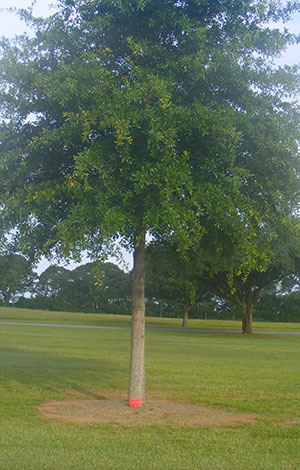For More Info...Alice Lucille Rench Patrick (February 27, 1922 – November 3, 2007)
 Alice L. Patrick (nee Rench) is the mother of Dr. Sarah E. Patrick, a professor of mathematics at Troy University Dothan Campus for 31 years (retired 2010).
Alice L. Patrick (nee Rench) is the mother of Dr. Sarah E. Patrick, a professor of mathematics at Troy University Dothan Campus for 31 years (retired 2010).
Alice Rench was born in a rural area in southwest Ohio somewhere between Troy and Dayton. A teenager during the depression, she quit school in the tenth grade to go to work and help her family. After her mother died in the 1940’s, she took over raising her youngest brother who was 12 at the time. During the war years, she worked at a factory that made electric motors and also spent time volunteering at the local USO. She met Robert C. Patrick who was stationed at Wright Patterson Air Base, and after a two-month courtship married him on July 9, 1943. Their daughter, Sarah Emmaline Patrick, was born on July 12, 1945 in Dayton, Ohio. In 1945, the family moved to Armuchee, Georgia. Mrs. Patrick worked at the glove mill in Summerville, GA, then an in-home sewing job, then Arrow Shirt Company until she took a leave to care for Mr. Patrick who had retired and fallen ill with Parkinson’s disease. The Patricks had moved to Cobb County, where Mrs. Patrick remained for a decade after Mr. Patterson died in 1991. Suffering a stroke in 2000, she moved to a nursing facility at Graceville, Florida, then to Dothan, Alabama, to be near her daughter. She died of cancer in November, 2007.
NUTTALL OAK
 “Nuttall oak (Quercus nuttallii), not distinguished as a species until 1927, is also called red oak, Red River oak, and pin oak. It is one of the few commercially important species found on poorly drained clay flats and low bottoms of the Gulf Coastal Plain and north in the Mississippi and Red River Valleys. The acorn or winter buds identify Nuttall oak, easily confused with pin oak (Q. palustris). The lumber is often cut and sold as red oak. In addition to producing timber, Nuttall oak is an important species for wildlife management because of heavy annual mast production.” [Source - http://www.na.fs.fed.us/pubs/silvics_manual/volume_2/quercus/nutallii.htm]
“Nuttall oak (Quercus nuttallii), not distinguished as a species until 1927, is also called red oak, Red River oak, and pin oak. It is one of the few commercially important species found on poorly drained clay flats and low bottoms of the Gulf Coastal Plain and north in the Mississippi and Red River Valleys. The acorn or winter buds identify Nuttall oak, easily confused with pin oak (Q. palustris). The lumber is often cut and sold as red oak. In addition to producing timber, Nuttall oak is an important species for wildlife management because of heavy annual mast production.” [Source - http://www.na.fs.fed.us/pubs/silvics_manual/volume_2/quercus/nutallii.htm]
GENERAL INFORMATION ABOUT OAKS
“The term oak can be used as part of the common name of any of about 400 species of oak trees and shrubs in the genus Quercus (from Latin "oak tree). The genus quercus is native to the northern hemisphere, and includes deciduous and evergreen species extending from cold latitudes to tropical Asia and the Americas. Oaks have spirally arranged leaves, with a lobed margin in many species; some have serrated leaves or entire leaves with a smooth margin. The flowers are catkins, produced in spring. The fruit is a nut called an acorn, borne in a cup-like structure known as a cupule; each acorn contains one seed (rarely two or three) and takes 6-18 months to mature, depending on species. The "live oaks" (oaks with evergreen leaves) are not a distinct group, instead with their members scattered among the sections below.
The Common North American Oak Species: black oak, bur oak, cherrybark oak, laurel oak, live oak, Oregon white oak, overcup oak, post oak, pin oak, northern red oak, scarlet oak, Shumard oak, southern red oak, swamp chestnut oak, water oak, white oak, and willow oak.” [Source - http://forestry.about.com/cs/treeid/a/the_oak.htm]

The “For More Info” Project
The “For More Info” Project is a joint venture of The Wiregrass Archives and the Troy University Libraries funded in part by a generous grant from the Historic Chattahoochee Commission Seed Grant Program. Begun in 2015, “For More Info” provides a place to find biographical information and images of the people honored in the Memorial Tree Program established by the Dothan Beautification Board in 1991 and continued at Troy University Dothan Campus.
“For More Info” also provides organizational histories and biographical sketches concerning named buildings, rooms, and other facilities on campus.